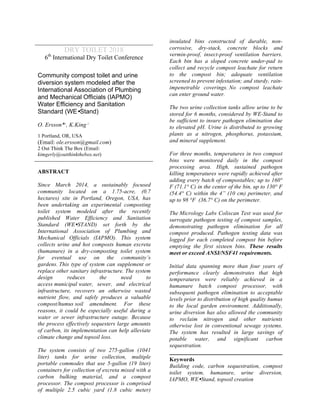[ABSTRACT] Community CompostToilet and Urine Diversion System Using IAPMO WEŌĆóStand ┬® 2018
- 1. DRY TOILET 2018 6th International Dry Toilet Conference Community compost toilet and urine diversion system modeled after the International Association of Plumbing and Mechanical Officials (IAPMO) Water Efficiency and Sanitation Standard (WE┼ĖStand) O. Ersson*1 , K.King 2 1 Portland, OR, USA (Email: ole.ersson@gmail.com) 2 Out Think The Box (Email: kimgerly@outthinkthebox.net) ABSTRACT Since March 2014, a sustainably focused community located on a 1.75-acre, (0.7 hectares) site in Portland, Oregon, USA, has been undertaking an experimental composting toilet system modeled after the recently published Water Efficiency and Sanitation Standard (WE┼ĖSTAND) set forth by the International Association of Plumbing and Mechanical Officials (IAPMO). This system collects urine and hot composts human excreta (humanure) in a dry-composting toilet system for eventual use on the communityŌĆÖs gardens. This type of system can supplement or replace other sanitary infrastructure. The system design reduces the need to access municipal water, sewer, and electrical infrastructure, recovers an otherwise wasted nutrient flow, and safely produces a valuable compost/humus soil amendment. For these reasons, it could be especially useful during a water or sewer infrastructure outage. Because the process effectively sequesters large amounts of carbon, its implementation can help alleviate climate change and topsoil loss. The system consists of two 275-gallon (1041 liter) tanks for urine collection, multiple portable commodes that use 5-gallon (19 liter) containers for collection of excreta mixed with a carbon bulking material, and a compost processor. The compost processor is comprised of multiple 2.5 cubic yard (1.8 cubic meter) insulated bins constructed of durable, non- corrosive, dry-stack, concrete blocks and vermin-proof, insect-proof ventilation barriers. Each bin has a sloped concrete under-pad to collect and recycle compost leachate for return to the compost bin; adequate ventilation screened to prevent infestation; and sturdy, rain- impenetrable coverings. No compost leachate can enter ground water. The two urine collection tanks allow urine to be stored for 6 months, considered by WE-Stand to be sufficient to insure pathogen elimination due to elevated pH. Urine is distributed to growing plants as a nitrogen, phosphorus, potassium, and mineral supplement. For three months, temperatures in two compost bins were monitored daily in the compost processing area. High, sustained pathogen killing temperatures were rapidly achieved after adding every batch of compostables; up to 160┬░ F (71.1┬░ C) in the center of the bin, up to 130┬░ F (54.4┬░ C) within the 4ŌĆØ (10 cm) perimeter, and up to 98 ┬░F (36.7┬░ C) on the perimeter. The Micrology Labs Coliscan Test was used for surrogate pathogen testing of compost samples, demonstrating pathogen elimination for all compost produced. Pathogen testing data was logged for each completed compost bin before emptying the first sixteen bins. These results meet or exceed ANSI/NSF41 requirements. Initial data spanning more than four years of performance clearly demonstrates that high temperatures were reliably achieved in a humanure batch compost processor, with subsequent pathogen elimination to acceptable levels prior to distribution of high quality humus to the local garden environment. Additionally, urine diversion has also allowed the community to reclaim nitrogen and other nutrients otherwise lost in conventional sewage systems. The system has resulted in large savings of potable water, and significant carbon sequestration. Keywords Building code, carbon sequestration, compost toilet system, humanure, urine diversion, IAPMO, WE┼ĖStand, topsoil creation

